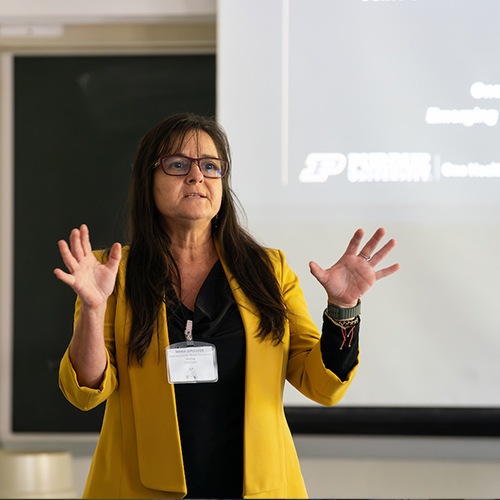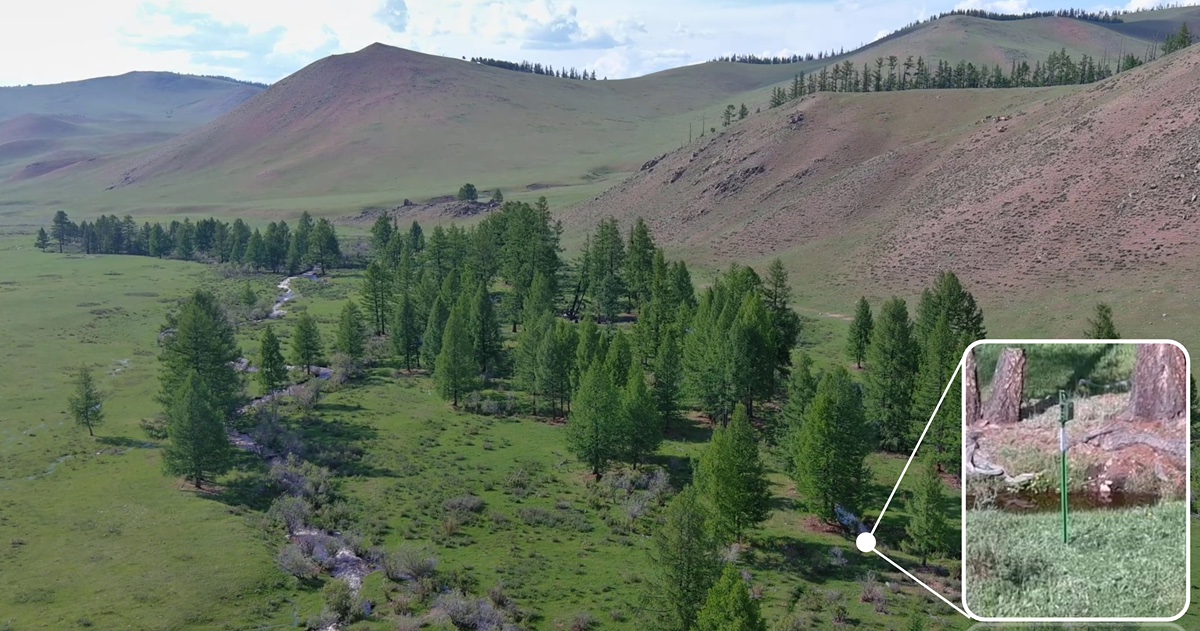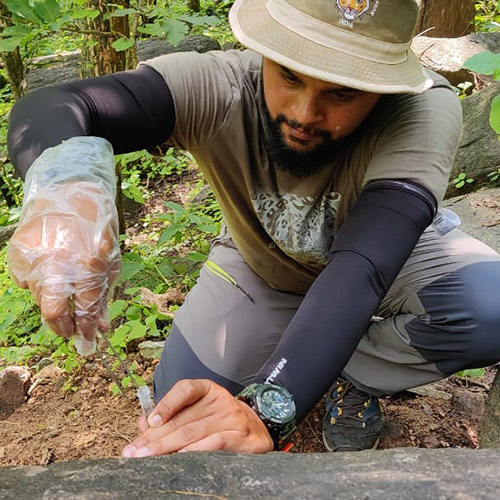Betty Jane "BJ" Meadows Named 2024 FNR Lifetime Achievement Award Recipient
Trailblazer: a pioneer or innovator; a person who makes a new track through wild country; a leader who is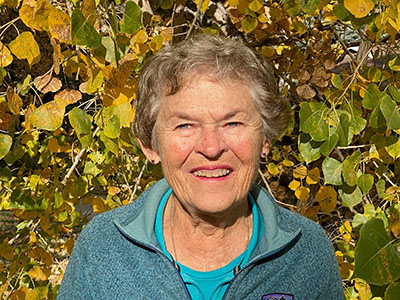 the first to do something or to go somewhere and who paves the way for others to follow.
the first to do something or to go somewhere and who paves the way for others to follow.
Betty Jane “BJ” Meadows was the first female graduate from Purdue’s master’s degree in forestry program in 1963, but that is only the tip of the iceberg when it comes to the impact made by an individual who has made it her life mission to introduce nature and experiential learning to students of all ages.
For her impact to the generations of women in forestry, wildlife management and environmental studies who have followed in her trailblazing footsteps, as well as her push to bring the outdoors to students of all ages, Purdue Forestry and Natural Resources is proud to honor B.J. Meadows as one of its 2024 Lifetime Achievement Award recipients.
““I’m most grateful to be a recipient of the FNR reward for 2024,” Meadows said. “As the first woman to receive a master’s degree in Wildlife Management from Purdue, I am delighted that women are currently being successful in this area. I am celebrating with them and sending them deep support. I felt like a trailblazer at the time, but there were a lot of mentors that worked with me to help me be successful at it. That has been my goal too -- to mentor other people in this whole process of learning by doing and being an advocate for the environment.”
Breaking Barriers
After earning her bachelor’s degree in science and philosophy with an emphasis in biology from Hanover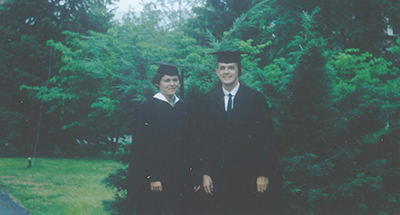 College in 1962, Meadows joined her high school sweetheart, Harold “Bud” Meadows on the Purdue campus. Bud had received his bachelor’s degree in pharmacy in West Lafayette, while BJ was at Hanover. The pair got married in 1963 and both began working on their master’s degrees at Purdue, BJ in forestry and Bud in bionucleonics.
College in 1962, Meadows joined her high school sweetheart, Harold “Bud” Meadows on the Purdue campus. Bud had received his bachelor’s degree in pharmacy in West Lafayette, while BJ was at Hanover. The pair got married in 1963 and both began working on their master’s degrees at Purdue, BJ in forestry and Bud in bionucleonics.
Meadows’s worked under Dr. Russell E. Mumford with the goal of someday becoming a forest ranger. Her master’s thesis was titled the “Ecological Study of Hawkins Wildlife Area.”
“(Professor) Russ Mumford knew about the Hawkins Wildlife Area and my interest in the environment,” Meadows recalled. “He went out there with me and helped me look at it and actually stake it out. My husband actually continued to help me stake it out and then I would go out there at least once a week to census the birds, mammals and plants to see the relationship of those. Nobody had ever valued that area and I thought that if I quantified what was out there, then maybe people would get more interested in it.”
Mumford also played another key role in Meadows’ success at Purdue, fighting for her right to take a required class never before available to females.
“I was passionate about getting my degree and then my advisor said this class is required but you can’t enroll because you are a female and it requires an overnight workshop and they don’t allow women to do that,” Meadows said. “I was so frustrated, but fortunately Professor Mumford came to my support and made it possible for me to take that class and then I was able to get my degree.”
Despite overcoming roadblocks on the way to getting her degree, Meadows still had to face a world that wasn’t quite prepared to hire women in the careers of forestry and wildlife management. But that again just brought forth her trailblazing spirit and she did it her own way.
Meadows spent more than 30 years in the K-12 educational space in Jefferson County, Colorado, as a teacher, administrator and innovator in collaborative leadership. She was instrumental in incorporating field biology and later environmental education into the curriculum and developing several supplemental programs to introduce students to the outdoors.
“They weren’t hiring women forest rangers at the time, so I became an educator and have managed wildlife ever since,” Meadows shared. “I was so interested in the environment from my previous history and my love of nature that I was captivated by the idea of building classrooms that got students into the environment. One of my main goals was to integrate all of the disciplines, because at that point, each discipline – science, social studies, language arts – was taught separately and it was so regimented. Through environmental education I could integrate those disciplines and help students understand how they interact. That was my passion for 30 years as an educator in the Jefferson County schools. I was able to use what I had learned at Purdue in terms of wildlife management and translate it into education.”
Bringing the Classroom Outdoors
Meadows began teaching in the Jefferson County School District in 1966, first as a biology teacher at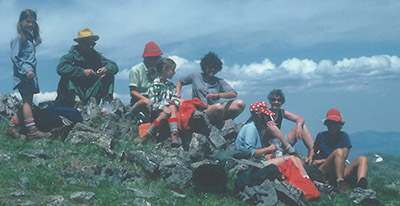 Alameda High School in Lakewood, Colorado. Her classroom had no windows, so Meadows went to her school principal and asked if she could take her students out into the environment, instead of just having them read about it in a text book. It took a few years, but soon field biology was part of the curriculum for Jefferson County Schools. The movement spread to many of the area high schools and Meadows would go on to earn the Outstanding Biology Teacher Award for the state of Colorado in 1971.
Alameda High School in Lakewood, Colorado. Her classroom had no windows, so Meadows went to her school principal and asked if she could take her students out into the environment, instead of just having them read about it in a text book. It took a few years, but soon field biology was part of the curriculum for Jefferson County Schools. The movement spread to many of the area high schools and Meadows would go on to earn the Outstanding Biology Teacher Award for the state of Colorado in 1971.
Harold Pratt was the coordinator of the science program for Jefferson County Schools and worked with Meadows to create and implement a K-12 environmental education program.
“My job was basically to get acquainted with the science teachers at the secondary level, so I was acquainted with BJ and saw her interests” Pratt said. “Field biology was not a regular offering in the curriculum, so the principal asked me if that was an acceptable course and I approved and supported it. Our next occurrence was when we submitted a proposal to the Jefferson Department of Education, a public school petition for environmental education programs. I wrote a proposal and we were given a grant for the development and injection of an environmental education program into the schools.”
From there, Pratt aimed to hire an environmental education coordinator. Meadows applied but was not selected. However, the story didn’t end there.
“BJ doesn’t settle for no as the final word, so she called me and said, ‘Let’s talk about why I didn’t get this job,” Pratt shared. “That was a reasonable request and I got better acquainted with her very quickly. The person that we did select tragically took off on a solo cross-country ski trip and died, which opened up the director position again and we voted and BJ accepted.
“As the district coordinator, she had a major impact on K-12 in a number of aspects. She did a number of things at the elementary level. She collaborated on the Eco Tracks Cooperative Development program called Topics in Applied Science at the middle school level, which covered the topics of technology, globalization and land use, environmental geology and energy, and survival in our environment. The program no longer exists, but it certainly did for a number of years and it put environmental education in the broader sense on the map in the district.”
The Topics in Applied Science program included professional learning experiences for teachers, laying out a model for how they could have outdoor and environmental education experiences with their students. It included local backpacking trips to the Grand Canyon and a canoe trip to Canyonlands National Park, planned and organized by Pratt and Meadows, all aimed at introducing teachers and students to the beauty and educational opportunities that nature can provide. Meadows and Pratt even collaborated on a hardbound text book that influenced the Jefferson County curriculum and eventually supported other schools in developing their own.
Meadows developed the Day on the Prairie program for seventh graders and Contemporary American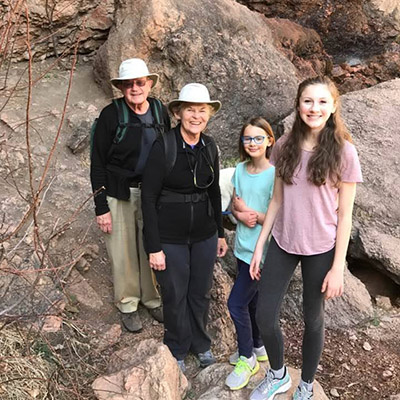 Issues for 10th graders among others in conjunction with the individual subject matter directors.
Issues for 10th graders among others in conjunction with the individual subject matter directors.
A program called Foothills and Freeways, took third grade students into the environments in the foothills of Colorado, as well as to the downtown environments, allowing them to compare the two and understand the importance for people in the urban environment to have accessibility to nature and open spaces and to appreciate their connection with nature.
The Eagle’s Nest and Owl’s Roost Environmental Discovery program, which received the National Science Teacher’s Award for Excellence in 1983, was developed for third and fourth grade students. The ENOR program had a lasting impact and still operates through Colorado State University’s Extension efforts today.
“BJ is a great mover and shaker and has a lot of good ideas,” Pratt said. “She is ambitious in a positive sense. She has to strike out in new areas and doesn’t let things get in her way. Environmental education was not in the mainstream curriculum anywhere in the country, so as an environmental education coordinator, she had to be strong willed and take the initiative and that was one of her strengths. We both had a strong interest in the outdoors and the power it has to serve as a learning environment and we formed a pretty good team working together for several years.”
Many of the programs that Meadows and Pratt developed had a profound impact on those who participated in them from teachers to parents and students alike.
Danica Kirkpatrick, director of the Purdue Agricultural Alumni Association, was a student at Stott and Freemont Elementary schools in Arvada, Colorado, and attended a Day on the Prairie event in elementary school.
“One of my favorite memories from elementary school was Day on the Prairie,” Kirkpatrick recalled. “We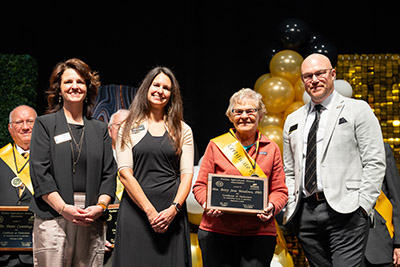 got to make leather medallion necklaces with our assigned tribe and collect beads as we made our way around the stations at Day on the Prairie. I haven’t been able to locate it, but I know that the memento that we created that day made several moves with me as a college student and young adult. My heart skipped a beat when I learned that BJ was the creator of that event.”
got to make leather medallion necklaces with our assigned tribe and collect beads as we made our way around the stations at Day on the Prairie. I haven’t been able to locate it, but I know that the memento that we created that day made several moves with me as a college student and young adult. My heart skipped a beat when I learned that BJ was the creator of that event.”
Kirkpatrick was able to present Meadows with the Purdue College of Agriculture’s Certificate of Distinction medal and plaque in February 2025.
Creating a Collaborative Community
Debra Oberbeck first encountered Meadows when her daughter Jessica was a kindergartener. What began with a story about a stuffed owl in her principal’s office turned into a 34-year friendship and influenced Oberbeck into public service, beginning as a Jefferson County School Board member.
“At some point, Jessica went to BJ’s office to deliver something from the teacher,” Oberbeck remembered. “BJ had a stuffed Northern Saw-whet Owl in her office. My daughter and I are birders and she immediately came home and told me about the owl in the principal’s office. I went in immediately, because I wanted to see what kind of owl she had. Our common love of birding started our friendship and relationship.”
Oberbeck says Meadows’ true strength as a principal was looking for parent leadership and building a community of people that wanted to be a part of their children’s lives in the school setting and to be responsible to and with the teaching staff. It was just natural for her.
“BJ spent all of the years that I worked with her when she was principal building community,” Oberbeck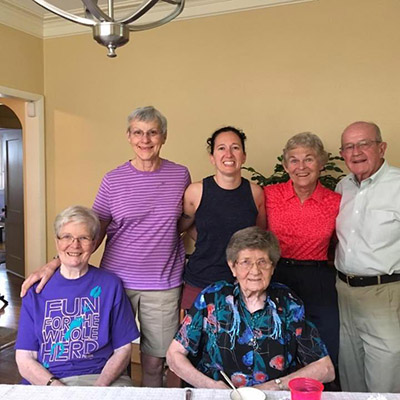 stated. “I know it sounds like it’s a little bit of a far stretch from forestry, but when you think about the basis of what her love was, there is nothing but community in nature and the way it all interacts. I think BJ brought her forestry knowledge into being a principal and understood that one ecosystem can’t survive without the other and that is why she looked for leadership. She looked for common ground between teaching staff and administrators and business people and church people and parents in those communities. BJ is remarkable. She inspires people to reach new heights that they didn’t know they could through a very calm and quiet demeanor.”
stated. “I know it sounds like it’s a little bit of a far stretch from forestry, but when you think about the basis of what her love was, there is nothing but community in nature and the way it all interacts. I think BJ brought her forestry knowledge into being a principal and understood that one ecosystem can’t survive without the other and that is why she looked for leadership. She looked for common ground between teaching staff and administrators and business people and church people and parents in those communities. BJ is remarkable. She inspires people to reach new heights that they didn’t know they could through a very calm and quiet demeanor.”
Oberbeck was one of those parent leaders that Meadows identified and it led to an eight-year stint with the Jefferson County Board of Education, including two years as the president.
“My role as a school board member came about because BJ came to me and said there’s a meeting going on at the district level nearby,” Oberbeck shared. “At the time, Jefferson County was the 26th largest school district in the country at the time, so when we started talking about the district level, I was coming from a tiny elementary school with maybe 250 kids. But BJ says, I want you to go the district and listen to this meeting and come back and report on it to our PTA and accountability committee. I said sure and that was the end of it. Every district piece of information that came across her desk, she went looking for a parent leader to represent her community. She sent a lot of people on to significant roles in the district and she was well-known in our district.
“BJ was the one who made connections with parents and she was remarkable. We had a saying in our local PTA that if you have a complaint, bring a solution. Don’t just say the complaint because nobody here is going to accept responsibility for it. We talk about it, find a solution together and we work on it. Eventually as my experience with the school district became more and more involved, it became very obvious to me that if I wanted to make changes, I had to step up and run for office. BJ and the teachers at the school encouraged me and that is how I took on that role. During the time I was serving on the board, the Columbine massacre happened. Having the strength of community around me during that time, including BJ, was significant for me. That community took care of me.”
And Oberbeck in turn took care of the next generation of educators and community partners. After eight years on the board, she created a partnership that facilitated relationships between administration, teacher and classified employee groups in school districts across the country.
“The goal was to put the three divergent communities in the same room before problems arose, before there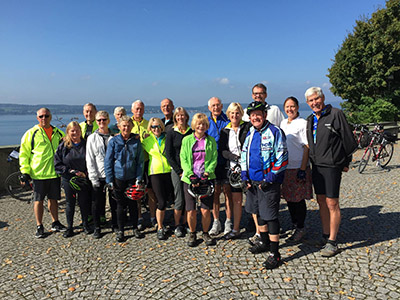 were conflicts to resolve,” Oberbeck noted. “My career after being a board member was directly spawned from my relationship and personal growth from being associated with BJ. There is no doubt in my mind. Due to BJ’s fun and quiet demeanor, she can be underappreciated. She is not a star-seeker and I love that this Lifetime Achievement Award is happening for her. She continues to be an important part of our lives all these years later.”
were conflicts to resolve,” Oberbeck noted. “My career after being a board member was directly spawned from my relationship and personal growth from being associated with BJ. There is no doubt in my mind. Due to BJ’s fun and quiet demeanor, she can be underappreciated. She is not a star-seeker and I love that this Lifetime Achievement Award is happening for her. She continues to be an important part of our lives all these years later.”
Offering Mentorship
Meadows then spent 10 years as an evaluator for the National Science Foundation. She spent many years in service through various advisory boards and task forces.
Dan Rose first met BJ when she was an NSF representative and he was doing research at the University of Colorado and was a member of the Industrial Advisory Board.
“BJ was the liaison between the National Science Foundation and that group,” Rose explained. “I was fairly young, in my twenties, when I got put in that role. BJ really took me under her wing at that time and really helped me fill that role as the chair of that board. She introduced me to her book on participative leadership. She shared that leadership is not about control, it is about enabling people and getting the most out of the team. And that is how our relationship formed.”
Rose spent the last 15 years of his career with Oracle Corporation working in data science and data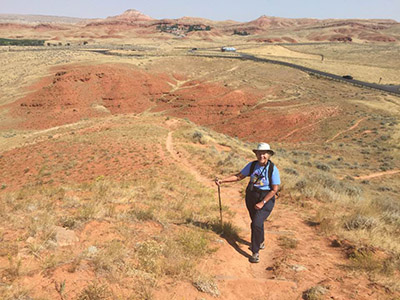 engineering. His most recent role saw him lead a multidisciplinary team that combined data science with machine learning, artificial intelligence and analytics with product development engineering and application development.
engineering. His most recent role saw him lead a multidisciplinary team that combined data science with machine learning, artificial intelligence and analytics with product development engineering and application development.
Although Meadows and Rose no longer worked together in a professional capacity, they maintained a friendship and mentorship that has lasted nearly 40 years.
“We actually have a phone conversation about every six weeks to this day,” Rose shared. “Our relationship centered around leadership. BJ filled the role in my career of being an impartial coach that I could go to and explain what was going on and get her perspective on it. Since then, it has morphed into talking about what is going on in a larger, more holistic view where we both talk about what’s going on in life and different ways to look at issues and different perspectives.
“BJ sees a larger picture than most people do and she can bring that perspective into someone’s life and help them see things in a different way. It relieves stress and helps give you a plan of attack, so the effect is really calming. It gives you a better picture of life and the problems you are facing. My personality is more of putting the family or team first; self-sacrificing is the first thing I do to achieve a goal. BJ has taught me how to balance that and think about the bigger picture and how to take care of myself. You read about people that take care of themselves for the patient, I think that is the kind of unique and uncommon perspective that BJ brings to people.”
Sharing Knowledge
BJ shared her knowledge and experience through two books, Building School Communities: Strategies for Leadership and Reflections: Learning by Doing, both co-written by Marilyn Saltzman, a former colleague in the Jefferson County School District. Saltzman first met Meadows when she was manager of communications for Jefferson County Schools and Meadows was a principal in the district. The two became friends while working on a collaborative decision-making task force.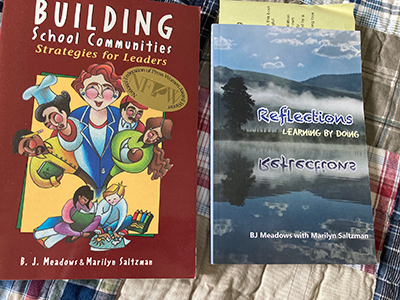
“I worked with other principals helping them with crisis management or different communications things, so I knew BJ from working with all of the principals, but we became friends when we were on the task force together, because we had similar interests and similar philosophies of education,” Saltzman said. “Then, after we both retired, she asked me to help her write her book, based on how she implemented cooperative decision making into education. She really was a leader in that field, involving teachers and parents in her school and decision making.
“BJ is an innovator and a champion for parents and teaching and doing what is right for them in education and that has a long-lasting impact. Some of the programs she initiated are still going on today. She is really value driven and she is courageous. Even though corporate decision-making might not have been a big push at the time, she was a front runner in that. And even though environmental education might not have been a big issue here in Colorado, she instituted field biology and getting kids out of the classroom and into the nature. She believed in it and really stuck with it and advocated for parents and kids. Even though it wasn’t popular at the time, she was very strict and principled. That is one of things I really admire about her.”
Saltzman and Meadows worked together on the two books for several years, meeting for hours every week or two. When they completed Building School Communities, they took the show on the road, presenting the topic at principals’ conferences in Texas and in Colorado, spreading the word about how to be collaborative and to build a school community through collaborative decision making.
Through the years, the two developed a deep friendship and mentorship.
“She is an incredibly loyal friend,” Saltzman said. “Once a month we - she and her husband and my husband and I – go to the symphony. Or in the summer when there’s no symphony, she’ll call and say, let’s get together for a picnic or lunch. She makes sure to keep her friendships going. It has been more than 20 years since we’ve both retired and not a month goes by that we don’t see each other. She is the one who makes sure it happens. She is incredibly generous with her time, with her love and in her praise. She is caring and is a generous and compassionate person and I have been the beneficiary of both of those attributes. You couldn’t ask for a better friend than BJ Meadows.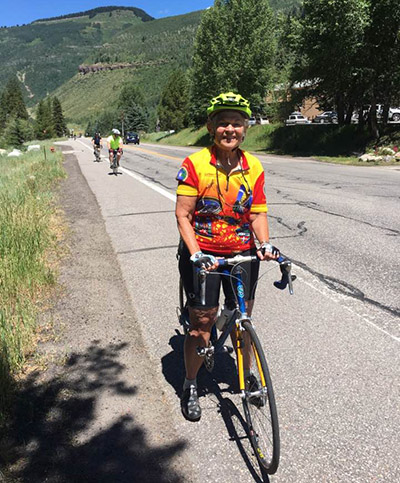
“I would also call her a mentor. She taught me a lot about the environment. She taught me a lot about friendship. She taught me a lot about collaboration. In our writing projects together, our styles are a little different. I’m a New York born and bred type-A personality, and BJ is a little more thoughtful and doesn’t move quite at the pace I do. But, we learned to work with and benefited from someone whose style was a little different than our own.”
Encouraging Life-Long Learning
Meadows has continued to promote education and mentorship in retirement, helping develop the curriculum and acting as a facilitator with the Osher Lifelong Learning Institute (OLLI) through the University of Denver, all while continuing to learn herself.
Karen Thorne, retired operating manager of OLLI, first met BJ in 2006 when she was charged with opening a new learning site in the Golden, Colorado, area. To launch the new site, Thorne had to recruit volunteers in the community who were leaders and also interested in education to lead academic courses in history, science and the arts
“From the very beginning, BJ was on our planning committee to open the site,” Thorne recalled. “OLLI is a group learning program, where many of the people attending are highly educated retired individuals. We have facilitators instead of teachers because they lead the classes but are also learning alongside the others in the class. B.J. was one of the first facilitators and also helped me find other facilitators. She has been instrumental in keeping it going.”
The program in Golden started with 90 people in 2007 and now boasts more than 400 attendees. It is not only Meadows’ knowledge and dedication that has made OLLI a success in Golden, she is a true ambassador of the program as both a facilitator and attendee.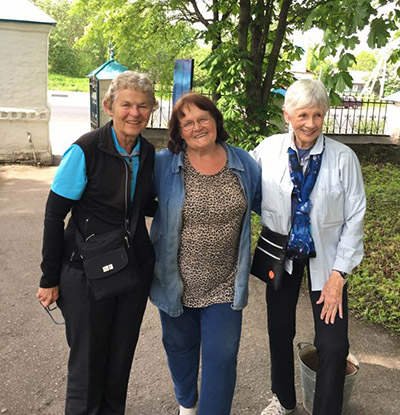
“BJ has been on the curriculum committee, the marketing committee, every committee we have ever had, she has been on it, and she has been steadfast in keeping that learning site open and active,” Thorne said. “That site has remained solid since 2007 and I think part of that is due to BJ and her keeping everyone going. Her determination to make it work and see it through is really inspiring. She is one of those people I always knew would be there and that I could count on to help me with something. These are all volunteers and the work they do is very time consuming, but she has never faltered. I don’t know where this program would have been without her.”
“BJ is always positive, always welcoming, always warm and she just invites people to trust her. She is one of the people that has been the face of this program and she is always encouraging people to get involved and really enjoy learning. She has just been wonderful. For me personally, I feel privileged to have had the opportunity to be a part of her life and get to know her. She holds a special place in my heart just because of her loyalty, her wonderful optimism, warmth and generosity.”




